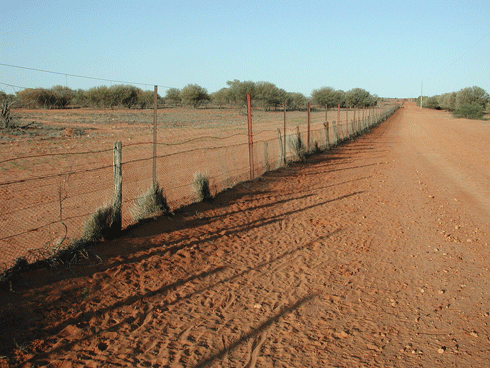Published: 2 July 2013
Dog-fence proposal reignites debate over role of dingoes
Thomas Newsome
Queensland’s Premier, Campbell Newman, recently announced funding for a feasibility study into resurrecting the wild dog fence in the state’s central west. The move comes in the wake of local farmers reporting dramatic stock losses – totalling $3 million dollars in annual revenue – from wild dog attacks.

|
|
Wildlife protector, farmer’s enemy or both? The full impact of dingoes in Australia’s ecosystems remains unclear, although their impact on sheep-grazing has been devastating. Credit: Thomas Newsome
|
The outcome of the $30 000 feasibility study is predictable. Given the estimated cost of $8 million dollars to build, and assuming its long-term effectiveness, the 800 km fence’s economic viability would appear justified.
But what goes largely unmentioned are the ecological consequences of creating a new barrier to wildlife movement. The dog-fence proposal also brings to a head the deceptively simple issue that is polarising Australian scientists working in the field: are dingoes ecologically good or bad?
Other than humans, the dingo (Canis lupus dingo) is Australia’s largest mammalian predator. Fossil records indicate it has been present on the mainland for at least 4000 years. Certainly, Indigenous Australians killed dingoes, but it was the arrival of Europeans that marked the beginning of intensive dingo control and exclusion. Australia’s famous ‘dingo fence’ – at 5500 km, the world’s longest man-made structure – was erected to exclude dingoes from Australia’s prime grazing land in the south-east quarter of the continent.
If the Queensland arm of the dog fence goes ahead, and if there is broad participation from all farmers in efforts to control wild dogs, dingoes will be excluded from vast tracts of land. What this will mean for the ecology of the area around the fence and beyond is still unclear.
In 2001, Alan Newsome and colleagues demonstrated that the existing 5500-km dingo fence has created two different ecological systems. One – in New South Wales – is dominated by sheep-grazing. The other – in South Australia – is dominated by cattle-grazing and includes dingoes.
Importantly, the researchers found that the introduced European red fox was less abundant in South Australia, where dingoes were present. This is consistent with the concept of ‘meso-predator interactions’ – that is, how larger predators directly and indirectly interact with smaller ones.
According to the meso-predator release hypothesis, the abundance of smaller predators, such as the red fox and feral cat, should decrease in the presence of a larger predator such as the dingo. Studies by Mike Letnic and colleagues (2011) have supported this theory , finding a negative correlation between dingo and red fox abundance in long-term bounty collection records and in data collected along the dingo fence.

|
The existing dingo fence between Queensland and NSW.Credit: spelio under CC BY-NC-SA 2.0 licence
|
The potential implications of the meso-predator release hypothesis have led to widespread predictions of species losses in areas from which dingoes have been removed. This is because predation by red foxes and feral cats is linked with catastrophic declines in populations of small- and medium-sized native mammals and other small vertebrates.
Given what’s at stake, one might expect that Premier Newman’s dingo-fence proposal is precisely the type of infrastructure that would benefit from a thorough environmental impact assessment. However, the bewildering mass of Commonwealth and Queensland legislation leaves it unclear whether, as a matter of law, an environmental impact assessment is required. If the proposed dingo fence were characterised merely as ‘agricultural fencing’, an environmental assessment may not be required.
Whatever the technicalities of current law, the government’s real focus should be on finding out what we don’t know, and on how proper environmental assessments – including properly funded scientific research – might guide best-practice policy.
That’s not to suggest that quantifying the ecological impacts of a barrier fence is straightforward. Of the limited studies carried out to date, suppression of foxes and feral cats by reintroduced dingoes has not been demonstrated, nor have theories of meso-predator release been demonstrated by dingo removal.
An additional complication is the substantial debate around the purity and classification of dingoes as a species. Since European settlement, dingoes have been interbreeding with domestic dogs (Canis lupus familiaris). The terms ‘feral dog’, ‘wild dog’ and ‘free-ranging dog’ are often used to describe dingoes, hybrids and/or domestic dogs. A study by Danielle Stephens (2011) found that in south-east Australia 95 per cent of ‘wild dogs’ have domestic dog genes .
Of course, pure dingoes still exist in many remote regions, particularly central Australia. But the ecological significance of inter-breeding is unknown. No studies have quantified if there are different behavioural traits of dingoes and hybrids. A significant impediment to doing so is that hybrids cannot reliably be identified in the field using body morphology and coat colour characteristics.
It is not surprising that much of the scientific evidence supporting positive management of dingoes has been questioned based on methodological flaws (by Ben Allen and colleagues in 2011 and 2013), the potential for dingoes to threaten some native prey (by Ben Allen and Peter Fleming in 2012), and because of the gaps in our knowledge (by Peter Fleming and colleagues in 2012).
What about studies elsewhere?
Internationally, the most high profile reintroduction program of a top-order predator involved wolves in Yellowstone National Park.
Coyote sightings were extremely rare in the Greater Yellowstone area prior to European settlement, when wolves were more common. After a period of wolf control in the early 1900s, coyote harvest numbers increased dramatically – a possible example of meso-predator ‘release’. Since the reintroduction of wolves into Yellowstone National Park in 1995-96, coyote densities have declined by 39 per cent.
This change in predator abundance is now the subject of much scientific study. For example, where wolves are now regulating numbers of their main prey (elk), the impacts (through overgrazing) on plant communities are being reversed through regeneration of aspen trees.
The applicability of the Yellowstone model to Australian is yet to be determined and is the subject of ongoing study. If the research shows a basis for positively managing wild dogs, including dingoes, in Australia, a major change in policy and lifestyle will be required in affected areas. Unless viable alternatives to current stock management practices were found, cessation of wild dog control would drive a shift away from some agricultural enterprises, such as sheep grazing. That is a politically and economically unpalatable result.

|
|
Sheep farm, NSW: While guardian animals have long been used overseas, the size of, and stock numbers on, Australian sheep farms means stock aren’t so readily protected. |
Could we cease wild dog control efforts and maintain viable agricultural enterprises if there was an ecological mandate for doing so? The truth is that there are no proven alternatives to wild dog control. Some farmers have been using guardian animals – such as donkeys, alpacas, lamas or specially bred dogs – that bond with, guard and protect sheep from wild dog attacks. A 2012 survey of 150 livestock producers found that predation ceased for 65.7 per cent of respondents after a livestock guardian dog was obtained. A further 30.2 per cent of respondents reported a decrease in predation.
While the use of guard animals may not be viable over large areas or with high numbers of stock, the limited research conducted to date demonstrates it is at least an option worthy of exploration and further research.
Another possible option for areas where cessation of wild dog control would result in environmental benefits is compensation to farmers for stock-loss attributable to wild-dog attacks. This could be modelled, for example, on recent moves by Bush Heritage in Tasmania to pay landholders a per-hectare fee for putting portions of their land under conservation management.
These and other alternatives to traditional control programs are likely to remain novel and untested. But two future areas of research may change that. First, research on the meso-predator release hypothesis and on traditional control programs – such as exclusion fencing and baiting – may show that wild dogs have a positive ecological impact. Second, research into whether traditional methods are even effective in reducing the impact of wild dogs on livestock could also change current approaches to wild dog control.
Why is the dingo issue so important for the nation as a whole? At stake is the future of our ecosystems and biodiversity, which are being decimated by red foxes and feral cats. Also at stake is the future of Australia’s agri-ecosystems, particularly the sheep industry, which has long suffered from wild dog and red fox impacts. Neither side of this debate can afford for policy to be made or maintained in the absence of sufficient research. Only scientific research will ensure that our policies on wild dogs are appropriately adapted to the unique environmental challenges of the Australian landscape.
Dr Thomas Newsome is an Honorary Research Fellow of the Desert Ecology Research Group at the University of Sydney. He is this year’s Fulbright NSW Scholar, a scholarship sponsored by the New South Wales Government and NSW universities in association with the Australian-American Fulbright Commission.





